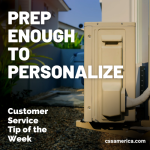Customer retention is vital. Most of next year’s customers are going to be those who are this year’s customers. So, the more you lose today, the fewer you will have tomorrow. Organizations conduct research, data mine, or bring in consultants to help identify those customers who may be most at-risk of being lost.
But every individual in an organization can help identify at-risk customers. Let’s ask some questions: When is a complaint a sign of risk? When is an issue a sign of risk? When is a lack of activity a sign of risk?
Defining Risk
By Risk we mean…Risk of losing a customer. Risk of having many customers having the same complaint or issue that your customer is experiencing. Risk of customers not using your services, not engaging with your business, finding other ways to get their needs met.
As with most aspects of customer service and retention, frontline staff are often best-positioned to help the organization as a whole.
Finding Organizational Issues
If the complaint is about a highly-used process or some aspect of the product or service, that could be a bigger risk for the whole organization if other customers are using that same process, product, or service. However, when a complaint is about an individual employee, that actually may not be a sign of risk for the whole company. Maybe it’s a localized situation.
When the issue being discussed is about organizational communications or tools such as website functionality or inconsistency in information flow or content, that could be a risk to the whole organization. However, if the issue is some characteristic of a transaction that’s unique to that person, that may have less likelihood to be a risk to the organization.
When the lack of activity is because the organization has not been reaching out to the customer, has not kept their relationship fresh, then that could be a risk to the whole organization. However, when the lack of activity is due to some change in circumstances in the individual’s life, it may not be a sign of risk for the whole company.
Issues that you see one-on-one with your customer may or may not be symptoms of bigger issues for the whole organization, but it’s helpful to the company for you to occasionally take a step back and consider whether a concern for one customer could also impact the many.
Determine if the customer’s issue is an organizational issue.
Signup for FREE Tips! Contact Us More Resources for You Visit Our Home Page
























